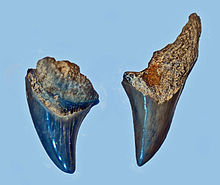| Parotodus | |
|---|---|

| |
| Fossil teeth of Parotodus benedenii | |
| Scientific classification | |
| Domain: | Eukaryota |
| Kingdom: | Animalia |
| Phylum: | Chordata |
| Class: | Chondrichthyes |
| Subclass: | Elasmobranchii |
| Order: | Lamniformes |
| Family: | incertae sedis |
| Genus: | †Parotodus Cappetta, 1980 |
| Type species | |
| †Parotodus benedenii Le Hon, 1871
| |
| Species | |
| |
Parotodus, commonly known as the false-toothed mako shark (or false mako shark), is an extinct genus of mackerel shark that lived approximately 53 to one million years ago during the Eocene and Pleistocene epochs. Its teeth, which are found worldwide, are often prized by fossil collectors due to their rarity. The scarcity of fossils is because Parotodus likely primarily inhabited open oceans far away from the continents. While the placement of Parotodus with the Lamniformes has been debated, most researchers agree it was probably a member of a now extinct shark clade, either a otodontid or a cardabiodont. In any case, it would have been the last members of either group. While originally being suspected of dying out at the very end of the Pliocene, fossils found in the Waccamaw Formation show that it made it to the Pleistocene.
- ^ Iserbyt, A.; De Schutter, P.J. (2012). "Quantitative analysis of Elasmobranch assemblages from two successive Ypresian (early Eocene) facies at Marke, western Belgium". Geologica Belgica. 15 (3): 147–156.
- ^ Steurbaut, E. (2006). "Ypresian". In Dejonghe, L. (ed.). Current status of chronostratigraphic units named from Belgium and adjacent areas. Vol. 9. pp. 73–93.
{{cite book}}:|journal=ignored (help) - ^ Boessenecker, S.J.; Boessenecker, R.W.; Geisler, J.H. (2018). "Youngest record of the extinct walrus Ontocetus emmonsi from the Early Pleistocene of South Carolina and a review of North Atlantic walrus biochronology" (PDF). Acta Palaeontologica Polonica. 63 (2): 279–286. doi:10.4202/app.00454.2018.